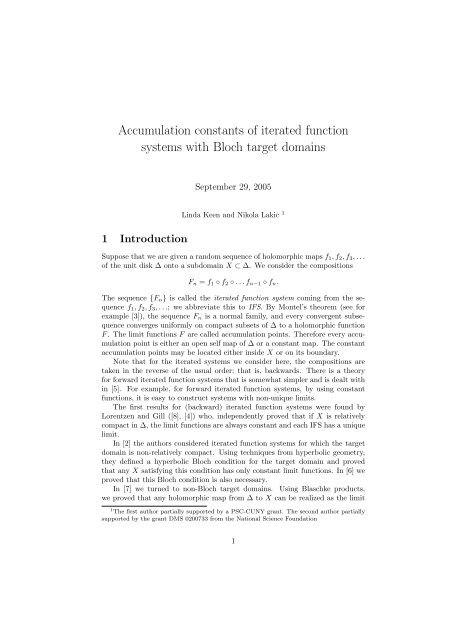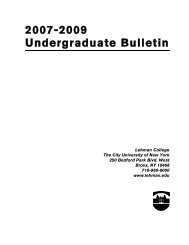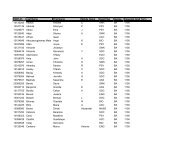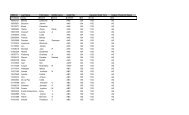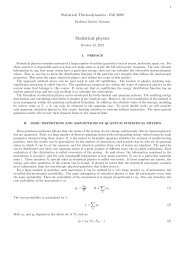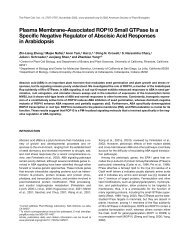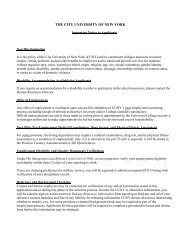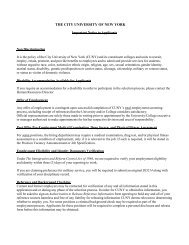Accumulation constants of iterated function systems with ... - CUNY
Accumulation constants of iterated function systems with ... - CUNY
Accumulation constants of iterated function systems with ... - CUNY
Create successful ePaper yourself
Turn your PDF publications into a flip-book with our unique Google optimized e-Paper software.
<strong>Accumulation</strong> <strong>constants</strong> <strong>of</strong> <strong>iterated</strong> <strong>function</strong><strong>systems</strong> <strong>with</strong> Bloch target domainsSeptember 29, 20051 IntroductionLinda Keen and Nikola Lakic 1Suppose that we are given a random sequence <strong>of</strong> holomorphic maps f 1 , f 2 , f 3 , . . .<strong>of</strong> the unit disk ∆ onto a subdomain X ⊂ ∆. We consider the compositionsF n = f 1 ◦ f 2 ◦ . . . f n−1 ◦ f n .The sequence {F n } is called the <strong>iterated</strong> <strong>function</strong> system coming from the sequencef 1 , f 2 , f 3 , . . .; we abbreviate this to IFS. By Montel’s theorem (see forexample [3]), the sequence F n is a normal family, and every convergent subsequenceconverges uniformly on compact subsets <strong>of</strong> ∆ to a holomorphic <strong>function</strong>F . The limit <strong>function</strong>s F are called accumulation points. Therefore every accumulationpoint is either an open self map <strong>of</strong> ∆ or a constant map. The constantaccumulation points may be located either inside X or on its boundary.Note that for the <strong>iterated</strong> <strong>systems</strong> we consider here, the compositions aretaken in the reverse <strong>of</strong> the usual order; that is, backwards. There is a theoryfor forward <strong>iterated</strong> <strong>function</strong> <strong>systems</strong> that is somewhat simpler and is dealt <strong>with</strong>in [5]. For example, for forward <strong>iterated</strong> <strong>function</strong> <strong>systems</strong>, by using constant<strong>function</strong>s, it is easy to construct <strong>systems</strong> <strong>with</strong> non-unique limits.The first results for (backward) <strong>iterated</strong> <strong>function</strong> <strong>systems</strong> were found byLorentzen and Gill ([8], [4]) who, independently proved that if X is relativelycompact in ∆, the limit <strong>function</strong>s are always constant and each IFS has a uniquelimit.In [2] the authors considered <strong>iterated</strong> <strong>function</strong> <strong>systems</strong> for which the targetdomain is non-relatively compact. Using techniques from hyperbolic geometry,they defined a hyperbolic Bloch condition for the target domain and provedthat any X satisfying this condition has only constant limit <strong>function</strong>s. In [6] weproved that this Bloch condition is also necessary.In [7] we turned to non-Bloch target domains. Using Blaschke products,we proved that any holomorphic map from ∆ to X can be realized as the limit1 The first author partially supported by a PSC-<strong>CUNY</strong> grant. The second author partiallysupported by the grant DMS 0200733 from the National Science Foundation1
<strong>function</strong> <strong>of</strong> some IFS. We also proved that many sets <strong>of</strong> open maps and <strong>constants</strong>in ¯X can be realized as limit <strong>function</strong>s <strong>of</strong> an IFS.In this paper we turn our attention to the possible limit <strong>constants</strong> for Blochtarget domains. We ask what points in X or ∂X can occur as limits. Our mainresult is that for a non-relatively compact Bloch domain X, any finite set <strong>of</strong>distinct points in X can be realized as the full set <strong>of</strong> limits <strong>of</strong> an IFS.We also give a new pro<strong>of</strong> <strong>of</strong> the Lorentzen Gill theorem based on reasoning in[2] and [6]. This theorem shows that if the target domain is relatively compact,the limit <strong>function</strong> must always lie inside X and not on its boundary. For non-Bloch domains, we saw in [7] that boundary points may be limit points. It is anopen question whether boundary points can be limit points for arbitrary nonrelativelycompact Bloch domains. Here we give two examples <strong>of</strong> special classes<strong>of</strong> non-relatively compact Bloch domains for which any boundary point may bea limit point.The paper is organized as follows. In section 2 we provide a pro<strong>of</strong> <strong>of</strong> theLorentz-Gill theorem and show that the limit point must be in X. In section 3we prove the main result that for a non-relatively compact Bloch domain any ndistinct points can be the limit set <strong>of</strong> an IFS. Finally, in section 4 we find twoclasses <strong>of</strong> Bloch domains for which any boundary point can be a limit point.2 Relatively Compact SubdomainsIn this section we consider <strong>iterated</strong> <strong>function</strong> <strong>systems</strong> where the target domainis relatively compact. We remark that if the <strong>function</strong> f 1 <strong>of</strong> any IFS is a constantmap, then f 1 ◦ . . . f n is the same constant map and this constant is theunique accumulation point. Similarly, if f k (z) ≡ c, c constant, then the uniqueaccumulation point <strong>of</strong> the IFS is the constant f 1 ◦ . . . f k−1 (c).We now make the tacit assumption that the <strong>function</strong>s in our IFS are nonconstant.We begin by recalling a theorem <strong>of</strong> Lorentz and Gill.Theorem 1 (Lorentz-Gill) If X is a relatively compact subset <strong>of</strong> the unit disk,then every IFS has a unique constant limit inside X. Moreover, every constantin X is the limit <strong>of</strong> some IFS.ρPro<strong>of</strong>. Set µ(X) = sup ∆ (z)z∈X ρ X (z) . Because X ⊂ ∆, for all z ∈ X, ρ ∆(z)
Integrating the left and right sides <strong>of</strong> this inequality along a path γ ⊂ Xjoining points z, w ∈ X that closely approximates the infimum and taking alimit gives us the strong contraction property,∫∫ρ ∆ (f(z), f(w)) = infγγρ ∆ (f(z))|f ′ (z)||dz| ≤ k infγγρ ∆ (z)|dz| = kρ ∆ (z, w)(2)Now suppose that some subsequence F nj <strong>of</strong> the IFS converges to a holomorphicmap g. The derivatives F n ′ j(z) converge to g ′ (z). Showing that g is aconstant map is equivalent to showing that F n ′ j(z) converges to zero. By theinfinitesimal strong contraction property, (1), we have|F ′ n j(z)| = |f ′ 1(f 2 f 3 . . . f nj z)f ′ 2(f 3 f 4 . . . f nj z) . . . f ′ n j−1(f nj z)f ′ n j(z)| ≤On the one hand, k n jρ ∆ (z)ρ ∆(g(z))kρ ∆ (f 2 f 3 . . . f nj z) kρ ∆ (f 3 f 4 . . . f nj z)ρ ∆ (f 1 f 2 f 3 . . . f nj z) ρ ∆ (f 2 f 3 f 4 . . . f nj z) . . . kρ ∆ (z)ρ ∆ (f nj z) =k n jρ ∆ (z)ρ ∆ (F nj z) .tends to zero, and on the other,ρ ∆ (z)ρ ∆(F nj (z))converges to< ∞. Therefore g′ (z) = 0 for all z in ∆, and every limit <strong>function</strong> isconstant.To show the constant is unique note that we only need to look at F n (0). SinceX is relatively compact, there is some positive B such that sup z,w∈X ρ ∆ (z, w) n, we apply the strong contraction property (2) m − n times toget,ρ ∆ (F m (0), F n (0)) = ρ ∆ (f 1 ◦ . . . f m (0), f 1 ◦ . . . f n (0))≤ k m−n ρ ∆ (f n+1 ◦ . . . f m (0), 0) < k m−n BThus, F n (0) is a Cauchy sequence and so has a unique limit.To see that the limit cannot be in ∂X, look at the IFS G n = f 2 ◦ f 3 ◦ . . . f n ;then, by the above, G n converges to a point a in ¯X. Since F n = f 1 ◦G n , however,F n converges to f(a) and f(a is in X.Finally, to show that any point a in X is the limit <strong>of</strong> some IFS, set f 1 ≡ a.Note that these arguments use the compactness and don’t work for nonrelativelycompact domains. They do still work, however, if we replace the unitdisk ∆ <strong>with</strong> an arbitrary source domain. □3 Non-relatively compact subdomainsWe turn now to the question <strong>of</strong> subdomains X that are not relatively compactin ∆. Although most <strong>of</strong> the arguments work for non-Bloch domains, we areinterested in the case when they are Bloch.3
In [5], in addition to our discussion <strong>of</strong> forward <strong>iterated</strong> <strong>systems</strong>, we showedthat if X is any non relatively compact subset <strong>of</strong> ∆, we could find a (backward)IFS that had two limit <strong>function</strong>s. Here we generalize this construction to showthat for every integer n, we can find <strong>iterated</strong> <strong>function</strong> <strong>systems</strong> <strong>with</strong> any givenset <strong>of</strong> n distinct points as the full set <strong>of</strong> accumulation points. A key to theconstruction isLemma 3.1 Let X be any non relatively compact subset <strong>of</strong> ∆, and for anyfixed n, let a 1 , . . . , a n be any distinct points in ∆ \ {0}. Then there exists a<strong>function</strong> f : ∆ → ∆ and points x 1 , . . . , x n ∈ X such that for all i = 1, . . . , n,f(x i ) = a i /x i .Pro<strong>of</strong>. We use the notation:and note that A(a, A(−a, z)) = z.A(a, z) = z − a1 − āzStep 1: Since X is not relatively compact we choose an x 1 ∈ X such that|x 1 | > |a 1 |. Let g 1 (z) be a self map <strong>of</strong> the unit disk to be determined. Definef(z) = A(x 1, z)g 1 (A(x 1 , z)) + a1x 11 + ā1¯x 1A(x 1 , z)g 1 (A(x 1 , z))It follows that f(x 1 ) = a 1 /x 1 as required. Because we want to work inductivelywe rewrite this definition implicitly as followsA(x 1 , z)g 1 (A(x 1 , z)) = A( a 1x 1, f(z)) (3)If n = 1 we set g 1 (z) ≡ 0 and we are done. From now on we assume that n > 1and that we have chosen x 1 .Step 2: Before we proceed, we set up some further notation:For 1 ≤ j ≤ k ≤ n set a jk = A(x j , x k ). Next, for k = 2, . . . n setFor j = 2, . . . n − 1 and k = j, j + 1, . . . n setb 1k = A( a 1x 1, a kx k) (4)b jk = A( b (j−1)ja (j−1)j, b (j−1)ka (j−1)k) (5)In order that our construction work we need to choose the x i so that thefollowing inequalities hold:In step 1 we chose x 1 so this holds for i = 1.| a ix i| < 1, i = 1, . . . n (6)4
We repeat this process for the n new points x 1 , b 2 , . . . b 2...(n−1) and obtain asecond set <strong>of</strong> n−1 distinct points x 2 , x 21 and b 3 , b 3...(n−1) and a <strong>function</strong> f 2 suchthat f 2 (x 2 ) = 0, f 2 (x 21 ) = x 1 andf 2 (0) = b 2 , . . . f 2 (b 3 ) = b 23 , . . . , f 2 (b 3...(n−1) ) = b 2...(n−1)We continue in this way. For i = 3, . . . , n − 1 start <strong>with</strong> the n − 1 pointsx i−1 , x (i−1)(i−2) , . . . x (i−1)...1 , b i , b i(i+1) , b i...(n−1)and obtain a <strong>function</strong> f i and n − 1 new pointssuch thatandx i , x i(i−1) , . . . , x i(i−1)...1 , b i+1 , b (i+1)(i+2) , . . . b (i+1)...(n−1)f i (x i ) = 0, f i (x i(i−1) ) = x i−1 , . . . , f i (x i(i−1)...1 ) = x (i−1)...1f i (0) = b i , f i (b i+1 ) = b i(i+1) , . . . , f i (b (i+1)...(n−1) ) = b i...(n−1)We thus obtain the first n − 1 maps and check that they satisfy f 1 (0) = c 1 ,f 1 ◦ f 2 (0) = c 2 , . . . f 1 ◦ . . . ◦ f n−1 (0) = c n−1 . Moreover, we have the points <strong>of</strong> thecycles such that• x 1 , . . . , x n−1 ∈ X satisfying f i (x i ) = 0, i = 1, . . . , n − 1.• x 21 , x 32 , . . . x (n−1)(n−2) ∈ X satisfying f i (x i(i−1) ) = x i−1 , i = 2, . . . , n − 1.• x 321 , x 432 , . . . x n(n−1)(n−2) ∈ X satisfying f i (x i(i−1)(i−2) ) = x (i−1)(i−2) , i =2, . . . , n − 1.• . . .• x (n−1)...21 ∈ X satisfying f n−1 (x (n−1)...21 ) = x (n−2)...21We now have n − 1 points <strong>of</strong> the first cycle, n − 2 points <strong>of</strong> the second andso forth. The next step is the general step; we need to complete the cycles.We construct a holomorphic map f n from ∆ to X to complete the first cycle;that is, so that f n (0) = x (n−1)...21 and f 1 ◦ . . . ◦ f n (0) = 0. We also obtain newpoints x n(n−1) , . . . , x n(n−1)...32 in X \ {0} in each <strong>of</strong> the second through n − 1-stcycles and start a new cycle <strong>with</strong> a new point x n . That is,. . .andf n (0) = x (n−1)...21 (11)f n (x n(n−1)...32 ) = x (n−1)(n−2)...32 (12)f n (x n(n−1)...43 ) = x (n−1)(n−2)...43 (13)f n (x n(n−1) ) = x (n−1) (14)f n (x n ) = 0 (15)7
For the construction <strong>of</strong> f n , we again begin <strong>with</strong> a covering map. Let π 1 bea holomorphic covering map from ∆ onto X such that π 1 (0) = x (n−1)...21 . Wenow choose any n − 1 points in ∆ that are preimages under π 1 <strong>of</strong> the danglingpoints <strong>of</strong> the cycles we are constructing as follows:. . .y (n−1)...2 such that π 1 (y (n−1)...2 ) = x (n−1)...2y (n−1)...3 such that π 1 (y (n−1)...3 ) = x (n−1)...3y n−1 such that π 1 (y (n−1) ) = x (n−1)y n such that π 1 (y n ) = 0These n−1 points together <strong>with</strong> 0 form a set <strong>of</strong> n distinct points in ∆. Usinglemma 3.1 we can find n − 1 points x n , x n(n−1) , . . . , x n(n−1)...32 in X \ {0} and a<strong>function</strong> g such that. . .g(x n(n−1)...2 ) = y (n−1)...2x n(n−1)...2g(x n(n−1)...3 ) = y (n−1)...3x n(n−1)...3g(x n(n−1) ) =y n−1x n(n−1)andg(x n ) = y nx nFinally, let f n (z) = π 1 (zg(z)). We have completed the first cycle so thatthe composition f 1 ◦ f 2 ◦ . . . ◦ f n fixes zero. We now repeat this construction adinfinitum to obtain f n+1 , f n+2 , . . .. At each stage we complete one cycle and addpoints to the next n − 1 cycles. Thus, the cycle relation, (9), holds for each i.Let F k = f 1 ◦ . . . f k . Then, F k (0) = c r where r = k mod n. The accumulationpoints are limits <strong>of</strong> subsequences {F nk }. For any such limit F , F (0) = c r forsome r = 0, . . . , n − 1. Because the c r are distinct, we have at least n distinctaccumulation points.If X is Bloch, all the limit <strong>function</strong>s <strong>of</strong> this IFS are constant. Since F (0) = c kfor some k for every limit <strong>function</strong> there are exactly n possible constant <strong>function</strong>s.□4 Boundary points as limiting valuesAs we saw in section 2, if X is relatively compact, all limit <strong>function</strong>s lie insideX. As we mentioned in the introduction, in [7] we proved that if X is non-Bloch,we can find an IFS whose limit <strong>function</strong>s take on any or all boundary points. IfX is Bloch and not relatively compact, however, it is not known whether we canobtain limits that are boundary points <strong>of</strong> X.In this section we exhibit two special classes <strong>of</strong> subdomains that do admit anIFS whose limit point does lie on the boundary. This gives an affirmative answerto our question for those non-relatively compact Bloch domains in these classes.8
Theorem 3 Let X be a subdomain <strong>of</strong> ∆ formed by removing an infinite collection<strong>of</strong> isolated points from ∆. For any boundary point b ∈ ∂X, there is an IFS<strong>with</strong> a limit <strong>function</strong> that takes the value b.Pro<strong>of</strong>. Choose some b ∈ ∂X; either b is one <strong>of</strong> the isolated boundary points<strong>of</strong> X or b ∈ ∂∆. Let c 1 , c 2 , . . . be a sequence <strong>of</strong> points in X that tend to b.Assume, <strong>with</strong>out loss <strong>of</strong> generality that the origin belongs to X. The idea <strong>of</strong> thepro<strong>of</strong> is similar to the one above, and works because, although the arguments inthe pro<strong>of</strong> <strong>of</strong> lemma 3.1 do not extend to an infinte number <strong>of</strong> points, we can usethe special nature <strong>of</strong> X to obtain an infinite point version <strong>of</strong> lemma 3.1.Let g 1 : ∆ → X be a covering map such that g 1 (0) = c 1 . It is uniquelydetermined up to pre-composition by a rotation about the origin. Since X is notsimply connected, we may pick points a 2 , a 3 , . . . in ∆ such that g 1 (a j ) = c j and|a j | < |a j+1 |. The setsA θ = {e −iθ a j : j = 2, 3, . . .}are disjoint for 0 < θ < 2π. Since ∆ \ X is countable, there exists θ such thatA θ ⊂ X. Let c 1j = e −iθ a j and let f 1 (z) = g 1 (e iθ z). Then f 1 (0) = c 1 , andf 1 (c 1j ) = c j for j > 1.We next construct f 2 in the same way. We choose a covering map f 2 so thatf 2 (0) = c 12 ; then f 1 ◦ f 2 (0) = c 2 . We choose preimages c 2j , j = 3, 4, . . . suchthat f 2 (c 2j ) = c 1j . We use the same argument as above to adjust f 2 so that allthese preimages lie in X.We repeat the construction for each n. We take f n as a covering map suchthat f n (0) = c (n−1)n and adjust so that we can find points c nj , j = n + 1, n +2, . . . , ∈ X <strong>with</strong> f n (c nj ) = c (n−1)j . Then f 1 ◦ . . . f n (0) = c n .Set F n (z) = f 1 ◦ . . . f n (z). Since c n → b, if G is a limit <strong>function</strong> <strong>of</strong> F n , thenG(0) = b.Note that if X is Bloch, then G must be constant, G(z) ≡ b. □Theorem 4 Suppose Y is non relatively compact subdomain <strong>of</strong> ∆ <strong>with</strong> locallyconnected boundary. Then, for any boundary point c ∈ ∂Y , there is an IFS <strong>with</strong>a limit <strong>function</strong> that takes the value c.Pro<strong>of</strong>. Let c ∈ ∂∆ ⋂ ∂Y. We will construct an IFS whose accumulation pointis c. All our maps f i will map the unit disk conformally onto Y. Let f be aRiemann map from the unit disk onto Y. By Caratheodory’s theorem f extendscontinuously to the boundary <strong>of</strong> the unit disk (see Theorem 2.1 in [3]). Thepreimage <strong>of</strong> c under this extension is a point on the unit circle, and precomposingby a Mobius map if necessary, we may assume that the continuous extension <strong>of</strong>f, which we will still call f, fixes c. Take a sequence z n <strong>of</strong> points in Y such thatz n converges to c. Then f(z n ) converges to c. Therefore there exists a point z n1such that |f(z n1 ) − c| < 1 2 . Let A 1 be a hyperbolic isometry <strong>of</strong> the unit disk suchthat A 1 (c) = c and A 1 (0) = z n1 . Let f 1 = f ◦ A 1 . Then|f 1 (0) − c| < 1 29
andlim f 1(z) = c.z→cTherefore f 1 (f(z n )) converges to c, and we may choose z n2 such that |f 1 f(z n2 )−c| < 1 4 . Now we take a hyperbolic isometry A 2 <strong>of</strong> the unit disk such that A 2 (c) = cand A 2 (0) = z n2 . Let f 2 = f ◦ A 2 . Then|f 1 f 2 (0) − c| < 1 4andlim f 2(z) = c.z→cIn this way, we obtain a sequence <strong>of</strong> maps f n from ∆ onto Y ⊂ X such that|f 1 f 2 . . . f n (0) − c| ≤ 12. Therefore c is the accumulation point <strong>of</strong> the IFSnf 1 f 2 . . . f n . Suppose now that c is any point on the boundary <strong>of</strong> Y and let fbe a Riemann map from the unit disk onto Y. Then there exists a point c 0 onthe unit circle such that f(c 0 ) = c. Precomposing f by a rotation if necessary,we may assume that c 0 ∈ ∂∆ ⋂ ∂Y. By the above, there exists an IFS F n whoseaccumulation <strong>function</strong>s all map 0 to c 0 . Then every accumulation <strong>function</strong> <strong>of</strong> theIFS G n = f ◦ F n maps 0 to c. □Examples <strong>of</strong> domains satisfying conditions in Theorem 4 are a those that meetthe boundary in a Stolz angle and polygons <strong>with</strong> ideal boundary.References[1] L. V. Ahlfors, Complex Analysis, McGrawHill, 1953[2] A. F. Beardon, T. K. Carne, D. Minda and T. W. Ng, Random iteration <strong>of</strong>analytic maps, J.Ergod. Th. and Dyn. Systems[3] L. Carleson and T. W. Gamelin, Complex Dynamics, Springer-Verlag(1993).[4] J. Gill, Compositions <strong>of</strong> analytic <strong>function</strong>s <strong>of</strong> the form F n (z) =F n−1 (f n (z)), f n (z) → f(z), J. Comput. Appl. Math., 23 (2), 1988, 179–184[5] L. Keen and N. Lakic Forward Iterated Function Systems,In Complex Dynamics and Related Topics, Lectures atthe Morningside Center <strong>of</strong> Mathematics, New Studies in Advanced Mathematics,IP Vol 5 2003.[6] L. Keen and N. Lakic Random holomorphic iterations and degenerate subdomains<strong>of</strong> the unit disk To appear, Proc. Amer.Math. Soc.[7] L. Keen and N. Lakic Limit <strong>function</strong>s for Iterated Functions Systems onNon-Bloch Domains In preparation[8] L. Lorentzen, Compositions <strong>of</strong> contractions, J. Comput. Appl. Math., 321990, 169–17810


